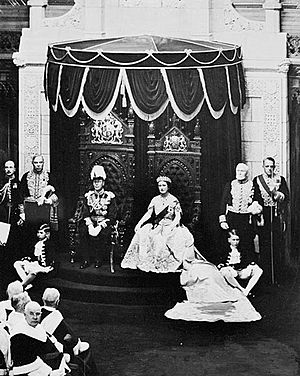King-in-Parliament facts for kids
The King-in-Parliament (or Queen-in-Parliament when a queen rules) is a special term in countries like Canada and Australia that are part of the Commonwealth realms. It means the King (or Queen) works together with the country's parliament to make laws. Think of it as the King being a key part of the law-making team.
When Parliament passes a new law, the King (or their representative, like a governor-general) must agree to it. This agreement is called Royal Assent. Once the King agrees, the proposed law officially becomes an Act of Parliament. Sometimes, the King can also make smaller rules, called secondary laws, with Parliament's approval.
Some countries that became independent from the United Kingdom now have a "President-in-Parliament." This means their president is formally part of the Parliament, just like the King is in other countries.
How Government Branches Work Together
The idea of the King being part of Parliament is linked to something called the fusion of powers. This means the government's main parts, the executive branch (which carries out laws) and the legislative branch (which makes laws), work very closely together.
This system is a core part of the Westminster system of government. It started in England and is now used in many countries around the world, especially in the Commonwealth. It's different from the idea of the separation of powers, where these parts are kept completely separate.
The term "Crown-in-Parliament" also reminds us that the King or Queen is seen as the ultimate authority. However, they usually let elected officials and others carry out their duties.
The King's Role in Making Laws
Because the King is involved in making laws, many new laws start with a special phrase. This phrase mentions the King and the other parts of Parliament.
For example, in the United Kingdom, new laws often begin with: "BE IT ENACTED by the King's most Excellent Majesty, by and with the advice and consent of the Lords Spiritual and Temporal, and Commons, in this present Parliament assembled, and by the authority of the same, as follows..."

Similarly, in Canada, new laws usually start with: "NOW, THEREFORE, His Majesty, by and with the advice and consent of the Senate and House of Commons of Canada, enacts as follows..."
In some places, like Australia and Tuvalu, the phrase is simpler. It might just say: "The Parliament of Australia enacts" or "ENACTED by the Parliament of Tuvalu..." This shows that Parliament is seen as the main law-maker.
The Scottish Parliament has a different way of doing things. Even though its laws need the King's approval, the Scottish Parliament gets its power from the United Kingdom Parliament. So, there isn't a direct "King-in-(Scottish) Parliament" idea. Instead, Scottish laws state: "The Bill for this Act of the Scottish Parliament was passed by the Parliament on (date) and received Royal Assent on (date)".

